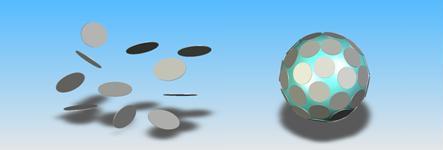A Robot Controlled by a Simulated Rat Brain
20 Aug, 2007 11:09 am
For a long time scientists have been quite intrigued by the rat?s ability to perform spatial tasks such as maze solving. Rats can combine scent and visual cues from the environment with their own sequence of body motions to recall a trajectory previously navigated. While for rats this may seem quite natural, for robots it is a major challenge. Working together with neuroscientists, a number of researchers in the robotics domain are taking inspiration from rat studies to develop robots with capabilities similar to those found in nature. In particular, our research group at ITAM ? Instituto Tecnol?gico Aut?nomo de M?xico has been developing a simulated rat brain to provide robots with cognitive capabilities in designing robot controllers analogous to learning and memory brain structures found in rats (Barrera and Weitzenfeld, 2007).
Modeling learning and memory in rats
In an area of the brain known as hippocampus, specialized neurons called place cells respond to a specific physical location in the environment. These responses are stored in brain representations referred to as cognitive maps (Tolman, 1948). It is believed that cognitive maps encode the integration of external cues perceived by the rat with kinesthetic information resulting from its own body movements (Jeffery and O’Keefe, 1999). Rats are able to learn the location of goals such as food or water and navigate back to them. Rats are also able to adapt their navigation after these goals have been moved around (O’Keefe and Nadel, 1978). This learning-unlearning process involves a reinforcement reward system linked to the striatum in the basal ganglia, the hippocampus, and the hypothalamus also related to the rat’s motivation to eat (Schultz et. al, 1998).
Robot experiments
A Sony AIBO robot has been employed to perform a number of different experiments inspired on “classical” rat spatial tasks. The first set of experiments involves a T-maze and an 8-arm radial maze, as shown in Figure 1. These experiments were designed to demonstrate the ability of rats to learn and unlearn by experimenting with a reversal task (O’Keefe, 1983). In this task, rats were trained initially to turn towards the left arm of the T by rewarding them with food at the end of that arm. When rats learned the correct turn, food reward was moved to the end of the opposite arm. As a result, rats unlearned what they had previously learned during training and built a spatial representation based on the maze shape. A somewhat similar experiment was carried out with the 8-arm maze to test more precisely the rotation increments it takes the rat to turn at each step. A second set of experiments was inspired by “Morris water maze” (Morris, 1981), where a hidden platform is placed inside a water tank. The tank is surrounded by external visual cues to facilitate the rat localization. The rat is initially trained to swim towards the platform in order to escape from the cold water. During tests, rats are able to find the hidden platform independently of the starting position. A comparable land-based experiment was devised by us to test the robot ability to find a yellowed colored mark representing the hidden platform as shown in Figure 2. The robot was trained to navigate from a fixed location until it located the target, and during tests, it was able to navigate directly towards the goal from any given starting location.

Figure 1. Robot implementation of O´Keefe rat experiments: (left) T-maze and (right) 8-arm radial maze used during the reversal task. The AIBO robot is located at the starting position and the goal location is indicated.

Figure 2. Robot implementation of Morris rat experiments: (left) In the land-based maze, the AIBO robot is located at the training starting position (TD), and the path to the goal is marked with an arrow. Visual cues are labeled as L1, L2 and L3. (right) Routes followed by the robot in three testing trials starting from locations D1, D2 and D3.
References
Barrera, A. and Weitzenfeld, A. 2007. Bio-inspired Model of Robot Spatial Cognition: Topological Place Recognition and Target Learning. Proceedings of the 7th IEEE International Symposium on Computational Intelligence in Robotics and Automation – CIRA 2007, Florida, USA.
Jeffery, K. and O’Keefe, J. 1999. Learned interaction of visual and idiothetic cues in the control of place field orientation. Experimental Brain Research – 127: 151-161.
Morris, R. G. M. 1981. Spatial localization does not require the presence of local cues. Learning and Motivation – 12: 239 – 260.
O’Keefe, J. “Spatial memory within and without the hippocampal system,” in Neurobiology of the Hippocampus, edited by W. Seifert, Academic Press, New York, pp. 375 – 403, 1983.
O’Keefe, J. and Nadel, L. 1978. The hippocampus as a cognitive map. Oxford University Press.
Schultz, W., Tremblay, L., Hollerman, J. 1998. Reward prediction in primate basal ganglia and frontal cortex. Neuropharmacology 37(4-5): 421-429.
Tolman, E. 1948. Cognitive maps in rats and men. Psychological Review – 55: 189-208.






